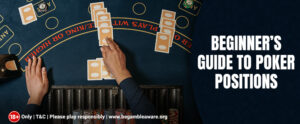Blog Posted on 14/06/2023 | Author: Karen Macarthur
A Beginner’s Guide to Poker Positions
The game of poker has been of interest to many; its attributes have been compared to striking a bargain in the market. Poker players and researchers, throughout their study of the game, ask the question whether performance is due to skill or just luck. Central to the study of poker is the eternal debate over whether the game is influenced by skill or governed by luck.
On the surface, the game is very simple, yet beneath the surface, the game is very deep. There are many variations of the game available that can be played at video poker tournaments and other events.
The simplicity and easy rules of the game can trick new players into believing they are experts in the game. But the game withholds underlying layers with poker tournament strategy and variations of game like double bonus poker, 3 card poker, and four card poker etc.
The Objective of Poker
Though it cannot be traced back to where poker originated, it does bear some resemblance to most of the card games that existed before poker began to take shape.
The poker terms used all share common literature and essential features. For example, the poker hand order in all the games is the same. In short, the hand rank decides the value of the player. The hand’s value is inversely correlated to its mathematical frequency, meaning the higher the hand rank, the more unusual the card combination.
Poker is a game played with 52 cards, and the rankings of the poker hands determine the likelihood of winning. The game begins by distributing the 52 cards among the players in a clockwise rotation. The card is distributed face-up until one of them receives the jack.
The player who receives the jack is the first dealer in the game. The dealer has to offer the shuffled card to the right to the opponent for a cut. The turn to deal and the turn to bet always pass to the left from player to player; it starts with the dealer. For each deal, any one of the players may shuffle the cards. The last person to shuffle the cards would be the dealer.
The Poker Positions
While luck undoubtedly plays a role, poker’s complexity and strategic depth elevate it beyond a mere game of chance. One crucial aspect that contributes to the game’s intricacies is the concept of poker positions.
Early Position
The concept of early position refers to the seats at a poker table that act before most other players in a betting round. Typically, the players in early position are seated to the left of the dealer button, commonly referred to as “under the gun”. Due to the disadvantage of acting first, players in early positions face limited information about their opponents hands, making their decisions more challenging.
In an early position, it is crucial to exercise caution and adopt a more conservative playing style. Strong starting hands, such as high pairs (e.g., ace, king) and premium hands ( Ace- King, Ace- queen) gain value in this position. These hands have a higher likelihood of remaining strong throughout the entire betting round. Conversely, weaker hands should be approached with caution, as they are vulnerable to stronger hands further along in the betting sequence.
Middle Position
In the middle position, players have a wider range of starting hands available to them. While it is still prudent to exercise caution with weaker hands, medium-strength hands gain value in this position. Hands like suited connectors (e.g., 8-9 suites) and medium pairs (e.g., 8-8 9-9) can be played more aggressively in an attempt to seize control of the pot.
Late Position
The late position, also known as the cutoff and the button, is the most advantageous position at the poker table. Players in the last position act last in each betting round, granting them the maximum amount of information about their opponents actions. This allows for more strategic and flexible gameplay, as they can adapt their strategy based on the actions of other players.
Poker positions play a significant role in a player’s strategic decision making process. While luck remains a factor in the game, understanding and capitalising on the advantages and disadvantages of each position requires caution and a tighter range of playable hands. The middle position offers more flexibility, and late position empowers players to exploit their positional advantage and adopt a more aggressive approach.
As poker players, researchers and mathematicians delve deeper into the game, the importance of skill becomes increasingly evident. Mastering the complexities of poker positions is just one facet of the game’s strategic depths. By honing their skills, players can tilt the balance in their favour turning the events of poker.



